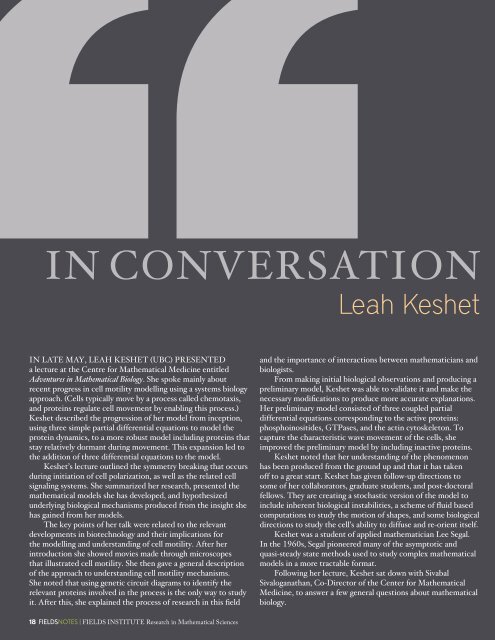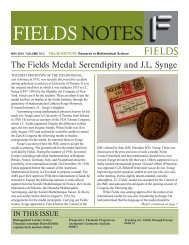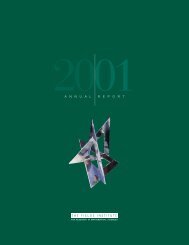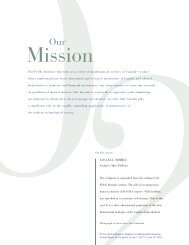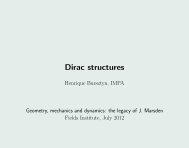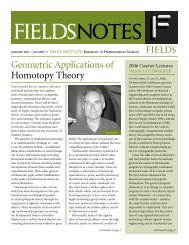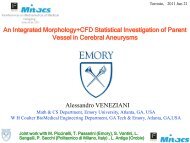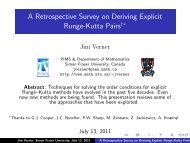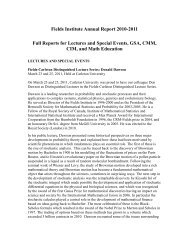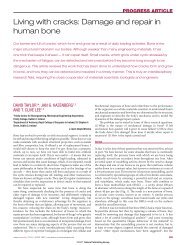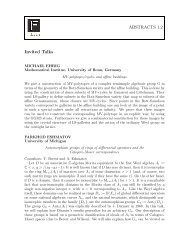SCIENTIFIC ACTIVITIES - Fields Institute - University of Toronto
SCIENTIFIC ACTIVITIES - Fields Institute - University of Toronto
SCIENTIFIC ACTIVITIES - Fields Institute - University of Toronto
You also want an ePaper? Increase the reach of your titles
YUMPU automatically turns print PDFs into web optimized ePapers that Google loves.
IN CONVERSATION<br />
IN LATE MAY, LEAH KESHET (UBC) PRESENTED<br />
a lecture at the Centre for Mathematical Medicine entitled<br />
Adventures in Mathematical Biology. She spoke mainly about<br />
recent progress in cell motility modelling using a systems biology<br />
approach. (Cells typically move by a process called chemotaxis,<br />
and proteins regulate cell movement by enabling this process.)<br />
Keshet described the progression <strong>of</strong> her model from inception,<br />
using three simple partial differential equations to model the<br />
protein dynamics, to a more robust model including proteins that<br />
stay relatively dormant during movement. This expansion led to<br />
the addition <strong>of</strong> three differential equations to the model.<br />
Keshet’s lecture outlined the symmetry breaking that occurs<br />
during initiation <strong>of</strong> cell polarization, as well as the related cell<br />
signaling systems. She summarized her research, presented the<br />
mathematical models she has developed, and hypothesized<br />
underlying biological mechanisms produced from the insight she<br />
has gained from her models.<br />
The key points <strong>of</strong> her talk were related to the relevant<br />
developments in biotechnology and their implications for<br />
the modelling and understanding <strong>of</strong> cell motility. After her<br />
introduction she showed movies made through microscopes<br />
that illustrated cell motility. She then gave a general description<br />
<strong>of</strong> the approach to understanding cell motility mechanisms.<br />
She noted that using genetic circuit diagrams to identify the<br />
relevant proteins involved in the process is the only way to study<br />
it. After this, she explained the process <strong>of</strong> research in this field<br />
18 FIELDSNOTES | FIELDS INSTITUTE Research in Mathematical Sciences<br />
Leah Keshet<br />
and the importance <strong>of</strong> interactions between mathematicians and<br />
biologists.<br />
From making initial biological observations and producing a<br />
preliminary model, Keshet was able to validate it and make the<br />
necessary modifications to produce more accurate explanations.<br />
Her preliminary model consisted <strong>of</strong> three coupled partial<br />
differential equations corresponding to the active proteins:<br />
phosphoinositides, GTPases, and the actin cytoskeleton. To<br />
capture the characteristic wave movement <strong>of</strong> the cells, she<br />
improved the preliminary model by including inactive proteins.<br />
Keshet noted that her understanding <strong>of</strong> the phenomenon<br />
has been produced from the ground up and that it has taken<br />
<strong>of</strong>f to a great start. Keshet has given follow-up directions to<br />
some <strong>of</strong> her collaborators, graduate students, and post-doctoral<br />
fellows. They are creating a stochastic version <strong>of</strong> the model to<br />
include inherent biological instabilities, a scheme <strong>of</strong> fluid based<br />
computations to study the motion <strong>of</strong> shapes, and some biological<br />
directions to study the cell’s ability to diffuse and re-orient itself.<br />
Keshet was a student <strong>of</strong> applied mathematician Lee Segal.<br />
In the 1960s, Segal pioneered many <strong>of</strong> the asymptotic and<br />
quasi-steady state methods used to study complex mathematical<br />
models in a more tractable format.<br />
Following her lecture, Keshet sat down with Sivabal<br />
Sivaloganathan, Co-Director <strong>of</strong> the Center for Mathematical<br />
Medicine, to answer a few general questions about mathematical<br />
biology.


